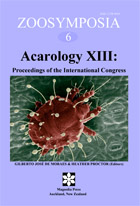Abstract
The poultry red mite, Dermanyssus gallinae (De Geer), is the most economically important ectoparasite in poultry houses in many countries around the world. The lack of efficacy of commercial products in its control results from poor application and/or from its resistance to active ingredients. A new insecticide, spinosad, was tested against mobile stages of the red mite in laboratory and field populations. Laboratory trials showed increasing efficacy five days (adults) and six days (nymphs) after exposure. Laboratory results were confirmed in a field trial conducted under commercial conditions. The trial was conducted in three separate houses on farms with high natural mite populations. The first and second houses were sprayed with concentrations of 2,000 and 4,000 ppm of spinosad (2 and 4 g/L), whereas the third house was used as an untreated control. Spraying was conducted using a sprayer (Stadikopumpe VAAR 252- 200 LE, Dinklage, Germany) with a 200 L reservoir with permanent stirring, a 50 m long flexible tube with a double jet system, and jet size of 0.08 mm. The pressure used was 6–10 bar. Sampling was conducted immediately before the application and once a week for 56 days in the first house and 93 days in the second. In the first house, almost 100% reduction in mite numbers was observed until 28 days post treatment; 74.3% reduction was observed 49 days after treatment. In the second house, rates of reduction were higher than 90% until day 77. The untreated control house maintained high red mite infestations throughout the experimental period. The results showed effective control of all mobile stages of D. gallinae with spinosad.

